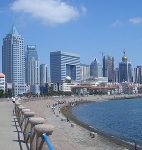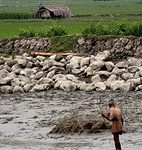So what do you do if you are the newly elected president of a small, relatively impoverished country whose greatest claim to fame, besides arguably the finest beaches in the world, is the fact that it is slowly sinking into the sea? You lose no time reminding the world of that fact, obviously. And to underline the urgency of the problem, you reveal the startling news that you are seriously thinking about moving the whole nation somewhere else.
That, at least, is what Mohamed Nasheed, the first democratically elected president of the Maldives, did recently. He aims to start setting aside a chunk of his country’s sizeable tourist revenue to set up a land-purchase fund. "We can do nothing to stop climate change on our own, so we have to buy land elsewhere. It’s an insurance policy for the worst possible outcome," he told the Guardian on the eve of his November 11 inauguration. "We do not want to leave the Maldives, but we also do not want to be climate refugees living in tents for decades."
It is an intriguing, if deeply depressing idea: the first nation on earth to be forced to abandon its homeland because of the impact of global warming and steadily rising sea levels. Nasheed is basically talking about relocating the Maldives’ 300,000-strong population to nearby India, or Sri Lanka or, possibly, Australia. But even if you accept the necessity of such a grim scenario, is it actually feasible? Could an entire people simply move to a new country, set up home there and pick up their lives again as if nothing except the unfortunate disappearance of their old base had actually happened?
The current consensus seems to be that it is not.
"It would be very difficult for a state, as such, to move," says Dr Gareth Price, head of the Asia programme at the London-based Royal Institute of International Affairs (Chatham House). "There can be ad-hoc migration, of course, even of quite large numbers. But there are big jurisdictional issues here, issues of sovereignty. That said, it is a real problem, and one we’re going to have to get used to. Nasheed is saying to the rest of the world: ‘We really have to think about this. We want to stay together, we don’t want to lose our culture, and this isn’t our fault’."
No one doubts the Maldives’ crisis is real. Made up of nearly 1,200 islands and atolls — 200 of them inhabited — in the Indian Ocean, it holds the record for the country with the lowest high point on earth: nowhere on the Maldives does the natural ground level exceed 2.3 metres. Most of its land mass, which totals roughly one-fifth of Greater London, is a great deal lower than that, averaging around 1.5 metres.
So, climate change will affect the Maldives more than most places. Sea levels in the area have risen by about 20 centimetres in the past century, and the United Nations estimates that they will rise a further 58 centimetres by 2100. The country and its capital, Malé, were inundated by unusually high tides in 1987, which caused millions of dollars worth of damage. The Asian tsunami of December 26, 2004, was even more devastating. The wave that struck the Maldives was barely a metre high, but it killed 82 people, displaced 12,000 more and inflicted US$375 million of damage (including US$100 million to the exclusive beachside resorts).
Tourists may be vital to the Maldives’ economy, but they are all but ignorant of its problems. The country is known as one of the world’s most upmarket destinations, its luxurious beachside bungalows proving particularly popular with honeymooning couples. Nearly 90 otherwise uninhabited islands have been turned into resorts that pull in more than 600,000 mostly European visitors each year. But while the average visitor apparently spends around US$300 a day, they will rarely come into contact with Maldivians. Transported to their atoll by speedboat or small plane, they don’t step off it except for a day cruise.
The tourism industry, though, accounts directly for maybe one-third of the Maldives’ GDP and at least 60% of its foreign exchange. Import duties and tourism-related taxes generate more than 90% of the government’s income; there is precious little other economic activity on the islands except for fishing. Few of those visitors are going to want to visit once their accommodation risks slipping, at any moment, beneath the waves.
The Maldives has been working for some time on one possible solution: constructing a new island, Hulu Malé, or New Malé. The government hopes to be able to transfer the populations of some of its lowest-lying atolls there — and, eventually, the capital (currently one of the most densely populated towns in the world) as well.
"They’ve been dredging the waters around the existing island to raise it to above the 2.1-metre mark," says Saleemul Huq, head of the climate-change group at the International Institute for Environment and Development (IIED). Some of the smallest inhabited atolls, Huq says, "are thinking in terms of relocation", but only, at this stage, within the archipelago.
Longer term, though, he adds, "if the measures we are taking to counter global warming do not prove sufficient, then it may well be that people will have to be moved further afield." Such eventualities already are being discussed, Huq says, with the United Nations Framework Convention on Climate Change (UNFCCC) providing an initial forum to talk through the "adaptation" of the most vulnerable countries. The island of Tuvalu, for example, is in talks with Australia about much the same kind of idea.
"But it’s plain," Huq adds, "that the relocation of entire populations is a source of major potential conflict." The Maldivian president mentioned India, Sri Lanka or Australia as possible hosts for his island people. In the case of the first two, at least, cultural differences for the islanders would be minimal (many islanders already work there, and wealthy Maldivians have been buying homes in Sri Lanka for years). Amid India’s 1.13 billion people, 300,000 Maldivians would not be a lot. But quite apart from the human cost of uprooting them, the international legal system is simply not up to the job.
"There isn’t really a big plot of land in either country which you could say is available," says Chatham House’s Price. "There’s a possible parallel with the case of the Bhutanese refugees in Nepal — the US has volunteered to take 60,000 of them. But that is a group of people, not a nation. And it’s hard to see what the Maldivians would do wherever they were to go: all they have is tourism and fishing. If they have money, I suppose somewhere in Africa might volunteer — maybe a place like Zanzibar could work? But the real problems would be constitutional: a state cannot play host to another state. In the case of Sri Lanka at least, the whole cause of its civil war is precisely this kind of federal issue."
Some experts see further legal problems down the line. The Inventory of Conflict and Environment (ICE) — based at American University in Washington, DC — foresees potential for conflict increasing within and beyond the Maldives as sea levels around the country rise. "It is possible that the Maldives would seek to be compensated by polluting countries for the loss of their islands," it suggests in an advisory paper.
"However,” it adds, “it is unclear whether the Maldives would seek new sovereign territory elsewhere. Additionally, it is unclear whether the Maldives would seek that territory in neighboring countries or elsewhere, such as in countries that contributed to the climate change in the first place, like the United States or China. Will a country that is threatened or destroyed by global warming demand compensation for its loss? Would the Maldives try to claim Washington, DC — which is roughly the same size as the Maldives’ territory — as compensation for the United States’ role in contributing to global warming?"
Tourism has made the Maldivians by far the wealthiest people in south Asia, with a GDP per head of more than of US$3,000. But the wealth is relative and the riches are thinly spread: in Guraidhoo, Kaafu atoll, nearly four years after the tsunami, families still live in bare breeze-block huts, within eyesight of the luxurious Kandooma Island resort. "Longer term, the issue of these low-lying island nations could start to become very problematic indeed," says Huq.
www.guardian.co.uk
Copyright Guardian News and Media Limited, 2008
Homepage photo by Cha…




